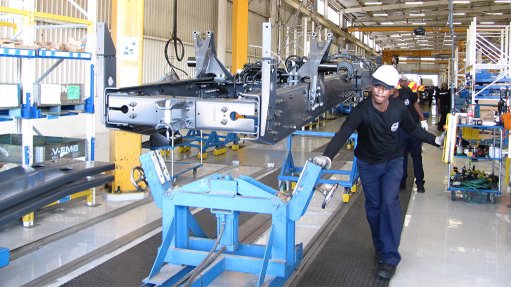
The Volvo truck plant in Durban
Photo by: Irma Venter
Volvo Southern Africa’s truck assembly plant, in Durban, will this year build 1 800 trucks and buses, up 500 units from the last eight years’ average of 1 300 units a year.
This comes as Volvo’s new truck ranges, the FH, FM and FMX, continue their roll-out in the local industry.
The Volvo truck plant, which assembles trucks from knock-down (KD) kits, builds Volvo trucks and buses, as well as Renault trucks.
Volvo Truck Industries GM Glen Owen says Volvo truck production alone has increased from an original forecast of 172 a month, to 196 trucks a month.
The Volvo truck plant was originally located in Botswana, but relocated to Durban in 2005, starting operations in January 2006, in a R41-million investment.
“Freight costs to and from Botswana were expensive, and 98% of our customer base was in South Africa,” explains Owen.
Employment has since increased from 60 people, to 99, of which 67 are assemblers.
The Volvo facility is 21 772 m2 in size, with 7 422 m2 under roof.
The plant has two production lines.
Line one has a capacity of ten trucks a day on a single shift, or 2 350 trucks a year.
Line two has a capacity of 1 175 units a year, and can also assemble bus chassis.
Owen considers the current capacity of around 3 500 units a year as “enough for now”.
With UD Trucks Southern Africa now in the Volvo fold, as is also the case with Renault Trucks, will UD’s plant move from Rosslyn, near Pretoria, to Durban?
No, says Owen. The Durban site is too small, and the brands remain strongly differentiated.
“There are no talks of amalgamating the sites. It they ever merged, it would probably require a greenfield site.”
Innovations at the plant in rolling out the new Volvo ranges include working on an upside-down chassis, before turning it around just before the chassis and truck marriage.
Prior to the R4-million investment by the Swedish group that enabled this, assemblers had to work on a right-way-up chassis.
“Ergonomically speaking, this is fantastic for the operator. There is no obstruction in putting on the valves, air tanks of chassis harnesses, for example,” says Owen.
Several pre-assemblies are also now completed alongside the assembly line, such as the rear suspension x-member and gearbox x-member.
Local content on the truck ranges include tyres, fifth wheels and chevrons.
All assembly kits come from Sweden, with the Durban plant one of the top two KD plants in the Volvo truck group.
Durban Harbour Biggest Challenge
Volvo Truck Industries’ biggest challenge in the local assembly of trucks and buses is congestion at the Durban port, says logistics manager Michael Kirrane.
The third and fourth quarters of 2013 saw congestion owing to matters such as wind, labour instability and power failures, he notes.
This has “huge cost implications” for the plant, says Kirrane.
The plant will typically in one week assemble the trucks from containers that arrived the previous week.
“This means it is time-sensitive. Congestion means we have to pay to build trucks in overtime, while also paying people to stand around with no work to do. It becomes frustrating and expensive.”